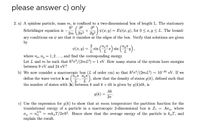Question

Transcribed Image Text:please answer c) only
2. a) A spinless particle, mass m, is confined to a two-dimensional box of length L. The stationary
Schrödinger equation is -
+a) v(x, y) = Ev(x, y), for 0 < r, y < L. The bound-
ary conditions on ý are that it vanishes at the edges of the box. Verify that solutions are given
by
2
v(1, y)
sin
L
where n., ny = 1,2..., and find the corresponding energy.
Let L and m be such that h'n?/(2mL²) = 1 eV. How many states of the system have energies
between 9 eV and 24 eV?
b) We now consider a macroscopic box (L of order cm) so that h'n?/(2mL?) ~ 10-20 eV. If we
define the wave vector k as ("", ""), show that the density of states g(k), defined such that
the number of states with |k| between k and k +dk is given by g(k)dk, is
Ak
9(k) =
27
c) Use the expression for g(k) to show that at room temperature the partition function for the
translational energy of a particle in a macroscopic 2-dimensional box is Z1 = Aoq, where
2/3
oq = ng = mk„T/2nh?. Hence show that the average energy of the particle is kT, and
explain the result.
Expert Solution
This question has been solved!
Explore an expertly crafted, step-by-step solution for a thorough understanding of key concepts.
Step by stepSolved in 2 steps with 2 images

Knowledge Booster
Similar questions
- Please don't provide handwritten solution ......arrow_forward18. Please answer question throughly and detailed.arrow_forwardConsider a particle of mass m which can move freely along the x axis anywhere from x=-a/2 to x=a/2, but which is strictly prohibited from being found outside this region (technically this is the infinite square well potential). 1. Verify that the attached wavefunction is a solution of the Schrodinger's equation. Consider V=0. 2. Deduce the value of the energy E. 3. Verify the uncertainty principlearrow_forward